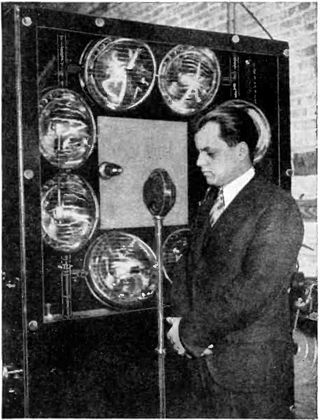
Very high frequency (VHF) is the ITU designation for the range of radio frequency electromagnetic waves from 30 to 300 megahertz (MHz), with corresponding wavelengths of ten meters to one meter. Frequencies immediately below VHF are denoted high frequency (HF), and the next higher frequencies are known as ultra high frequency (UHF).

Terrestrial television or over-the-air television (OTA) is a type of television broadcasting in which the signal transmission occurs via radio waves from the terrestrial (Earth-based) transmitter of a TV station to a TV receiver having an antenna. The term terrestrial is more common in Europe and Latin America, while in Canada and the United States it is called over-the-air or simply broadcast. This type of TV broadcast is distinguished from newer technologies, such as satellite television, in which the signal is transmitted to the receiver from an overhead satellite; cable television, in which the signal is carried to the receiver through a cable; and Internet Protocol television, in which the signal is received over an Internet stream or on a network utilizing the Internet Protocol. Terrestrial television stations broadcast on television channels with frequencies between about 52 and 600 MHz in the VHF and UHF bands. Since radio waves in these bands travel by line of sight, reception is generally limited by the visual horizon to distances of 64–97 kilometres (40–60 mi), although under better conditions and with tropospheric ducting, signals can sometimes be received hundreds of kilometers distant.
TV DX and FM DX is the active search for distant radio or television stations received during unusual atmospheric conditions. The term DX is an old telegraphic term meaning "long distance."

The All-Channel Receiver Act of 1962 (ACRA), commonly known as the All-Channels Act, was passed by the United States Congress in 1961, to allow the Federal Communications Commission to require that all television set manufacturers must include UHF tuners, so that new UHF-band TV stations could be received by the public. This was a problem at the time since most affiliated stations of the Big Three television networks were well-established on VHF, while many local-only stations on UHF were struggling for survival.

WLS-TV is a television station in Chicago, Illinois, United States, serving as the market's ABC network outlet. Owned and operated by the network's ABC Owned Television Stations division, the station maintains studios on North State Street in the Chicago Loop, and its transmitter is located atop the Willis Tower.
The following tables show the frequencies assigned to broadcast television channels in various regions of the world, along with the ITU letter designator for the system used. The frequencies shown are for the analogue video and audio carriers. The channel itself occupies several megahertz of bandwidth. For example, North American channel 1 occupies the spectrum from 44 to 50 MHz. See Broadcast television systems for a table of signal characteristics, including bandwidth, by ITU letter designator.
In North American broadcast television frequencies, channel 1 was a former broadcast (over-the-air) television channel which was removed from service in 1948.

WRGB is a television station licensed to Schenectady, New York, United States, serving the Capital District as an affiliate of CBS. It is owned by Sinclair Broadcast Group alongside CW affiliate WCWN. The two stations share studios on Balltown Road in Niskayuna, New York ; WRGB's transmitter is located on the Helderberg Escarpment west of New Salem.

WMVP is a commercial radio station licensed to Chicago, Illinois, carrying a sports format. Owned by Good Karma Brands, the station serves the Chicago metro area as the market affiliate of ESPN Radio, the flagship station of the Chicago Bears, Chicago White Sox, and the Chicago Wolves and is the home of local personalities David Kaplan, Tom Waddle and John Jurkovic. Formerly an ESPN Radio owned-and-operated station, WMVP's studios are co-located with WLS-TV in the Chicago Loop while the transmitter is located in Downers Grove. In addition to a standard analog transmission, WMVP is simulcast over the second HD subchannel of WSHE-FM and is available online.
The Llanddona transmitting station is a broadcasting and telecommunications facility, situated at Llanddona, near Beaumaris, on the isle of Anglesey, Wales. It comprises a 106.7 metres (350 ft) guyed mast with antennas attached at various heights. It is owned and operated by Arqiva.

The Wenvoe transmitting station, officially known as Arqiva Wenvoe, is the main facility for broadcasting and telecommunications for South Wales and the West Country. It is situated close to the village of Wenvoe in the Vale of Glamorgan, Wales, in the UK.

WSCR – branded as 670 The Score – is a commercial sports radio station licensed to serve Chicago, Illinois, the Chicago metropolitan area and much of surrounding Northern Illinois, Northwest Indiana and parts of the Milwaukee metropolitan area. Owned by Audacy, Inc., WSCR is a clear-channel station with extended nighttime range in most of the Central United States and part of the Eastern United States. WSCR is the Chicago affiliate for the BetQL Network, CBS Sports Radio, the Fighting Illini Sports Network and the NFL on Westwood One Sports; the flagship station for the Chicago Cubs and Chicago Bulls radio networks; and the home of radio personalities David Haugh and Matt Spiegel.
The 405-line monochrome analogue television broadcasting system was the first fully electronic television system to be used in regular broadcasting. The number of television lines influences the image resolution, or quality of the picture.
This is a list of pre-World War II television stations of the 1920s and 1930s. Most of these experimental stations were located in Europe, Australia, Canada, and the United States. Some present-day broadcasters trace their origins to these early stations.

A number of experimental and broadcast pre World War II television systems were tested. The first ones were mechanical based and of very low resolution, sometimes with no sound. Later TV systems were electronic.

Ulises Armand Sanabria was born in southern Chicago of Puerto Rican and French-American parents. Sanabria is known for development of mechanical televisions and early terrestrial television broadcasts.

The Blaenplwyf transmitting station is a broadcasting and telecommunications facility located near the village of Blaenplwyf about 10 kilometres (6 mi) to the south west of the town of Aberystwyth, in Ceredigion, Wales. It was originally built by the BBC, entering service in October 1956 acting as a main transmitter for BBC Band II VHF FM radio.

UHF television broadcasting is the use of ultra high frequency (UHF) radio for over-the-air transmission of television signals. UHF frequencies are used for both analog and digital television broadcasts. UHF channels are typically given higher channel numbers, like the US arrangement with VHF channels (initially) 1 to 13, and UHF channels (initially) numbered 14 to 83. Compared with an equivalent VHF television transmitter, to cover the same geographic area with a UHF transmitter requires a higher effective radiated power, implying a more powerful transmitter or a more complex antenna. However, the additional channels allow more broadcasters in a given region without causing objectionable mutual interference.
The Pan-American television frequencies are different for terrestrial and cable television systems. Terrestrial television channels are divided into two bands: the VHF band which comprises channels 2 through 13 and occupies frequencies between 54 and 216 MHz, and the UHF band, which comprises channels 14 through 36 and occupies frequencies between 470 and 700 MHz. These bands are different enough in frequency that they often require separate antennas to receive, and separate tuning controls on the television set. The VHF band is further divided into two frequency ranges: VHF low band between 54 and 88 MHz, containing channels 2 through 6, and VHF high band between 174 and 216 MHz, containing channels 7 through 13. The wide spacing between these frequency bands is responsible for the complicated design of rooftop TV antennas. The UHF band has higher noise and greater attenuation, so higher gain antennas are often required for UHF.











